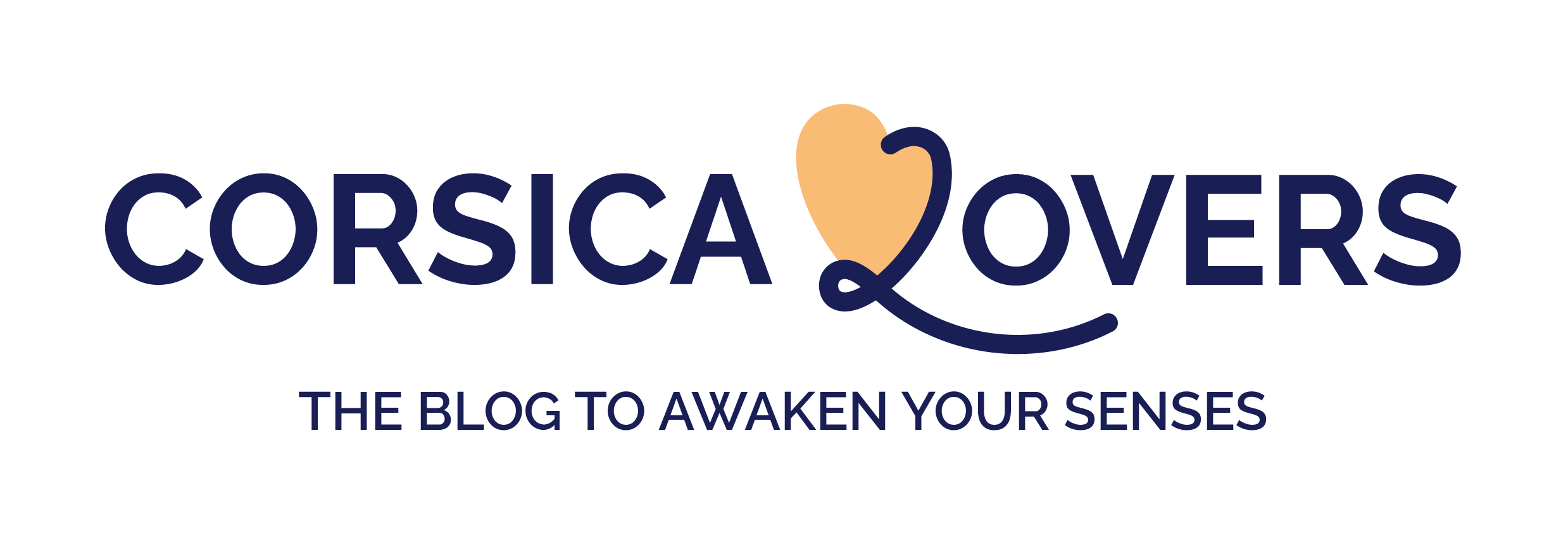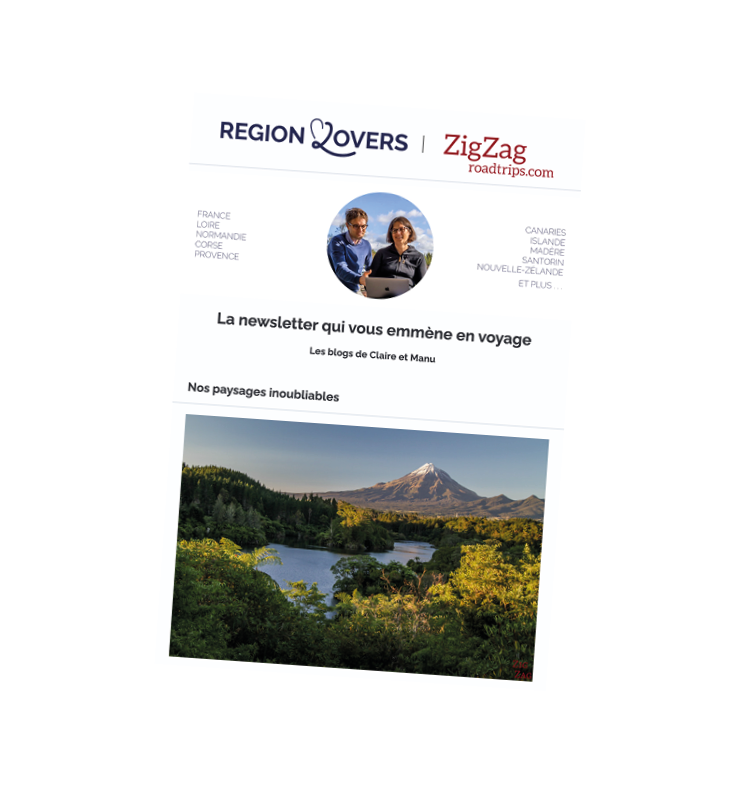On the east coast of Corsica, south of Bastia, Aleria is the ancient Roman capital of the island.
The historic village of Aléria is worth a visit with a major archaeological site, a museum and beautiful views.
Here is our guide to help you visit Aleria with: what to do, map, photos and tips.
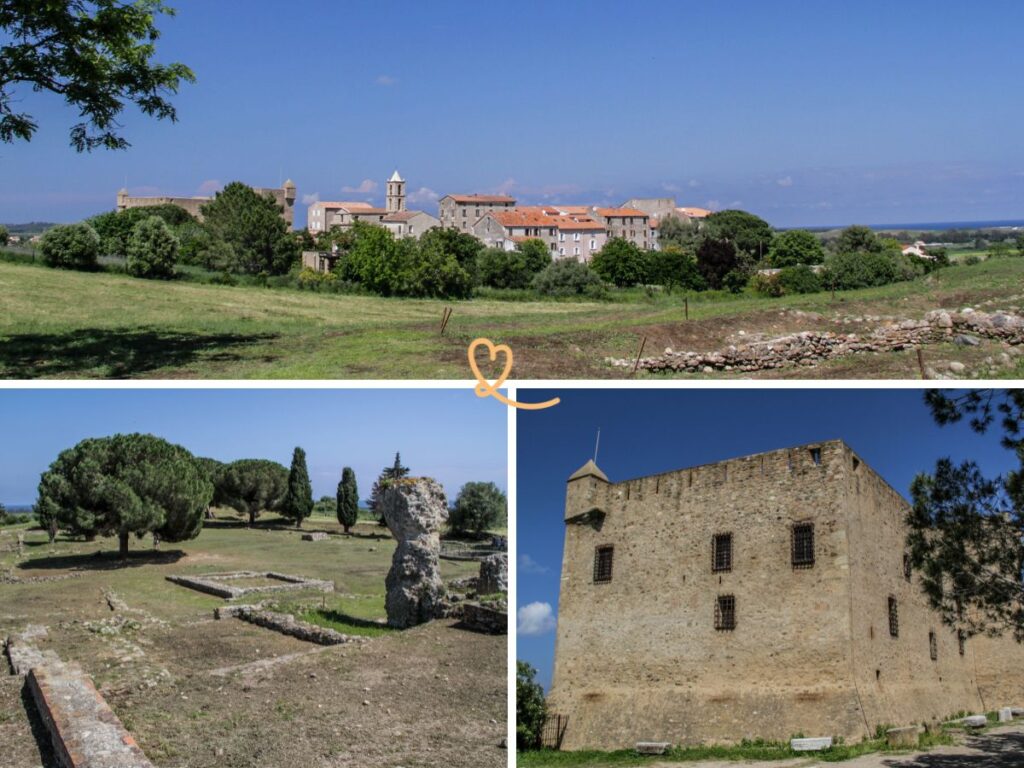
Why visit Aléria in Corsica? What to do?
Are the ruins and the museum of Aléria worth it?
Yes, if you like Roman history a lot.
Aléria and Mariana were the 2 main Roman colonies of Corsica.
For Aléria, the location was ideal, with an important river and good land for crops. Aléria, founded in the 6th century BC, is considered the oldest city in Corsica.
Aléria has a long history. Nowadays, you can visit the ruins with a breathtaking view of the area. In addition, the many artifacts found have been preserved and are on display in the nearby fort.

What to do in Aléria? Top 3
Aléria is not very big. You’ll quickly get the hang of it.
The main thing to do is:
- Walk around the village and enjoy the views all around
- Visit the Roman ruins
- Visit the museum of Aléria in the fort (Jérôme Carcopino Museum)
- and nearby, the Inzecca Canyon
More pictures after the practical advice.
Practical advice and map – Aléria, Corsica
Where is Aléria in Corsica ? Card
- Aléria is located in the center of the east coast of Corsica
- Along the main road T10 (on the coast)
- Or from inland, directly from Corte on the T50
- From Bastia to Aléria =1h15
- From Porto-Vecchio to Aléria = 1H15
- From Corte to Aléria = 45min
- From Ajaccio to Aléria = 2h
- Here is a map to help you find your way
- And see all our tips for planning a dream trip to Corsica here
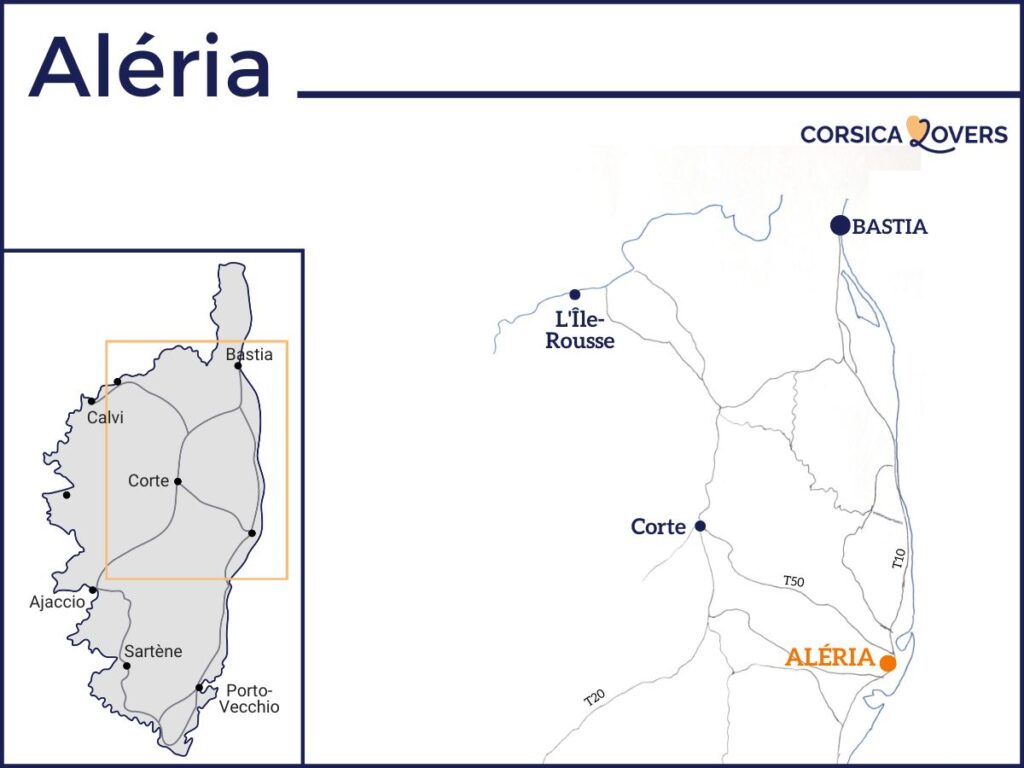
OUR TIPS FOR RENTING A CAR IN Corsica
- Compare prices on our preferred platform: DiscoverCars – one of the best rated sites.
- Choose a car that is powerful enough (the roads are steep) but compact (some passages are narrow).
- Think of thecomplete insurance (some roads are tortuous and narrow).
- There is a lot of demand, book it early.
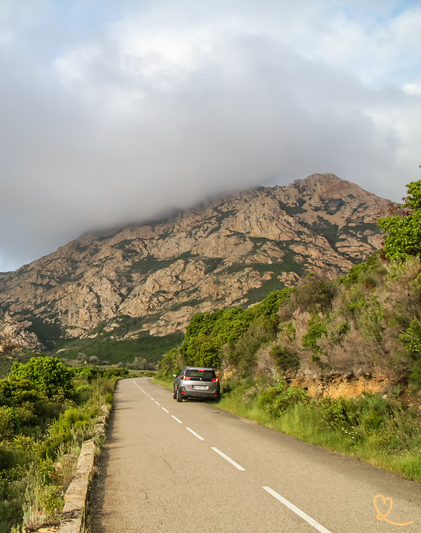
How to get to Aléria?
- The only way to explore the area is to rent a car.
- The site is very easy to access with good roads
- The Roman ruins are clearly marked as “Ancient Site” on the brown panels.

Parking in Aléria
Parking is easy to find.
It is a 5 minute walk from the museum.
It is quite large.
Sorry, we forgot to take a picture of the parking lot.
When to visit? How long
- Opening hours = at least from 10am to 12pm and from 1pm to 5pm, closed on Sundays.
- It is a pleasant visit whatever the weather and the time of the year.
- Allow half a day for the village, the museum and the site, if you have an interest in antiquity.
- The museum is not very big and neither are the ruins.

Visit Aléria – tips
- Easy access on foot
- A few steps in the museum
- Caution – Purchase your ticket to the fort museum before visiting the ruins.
It is best to visit the museum before the ruins to get a sense of the context. However, if you are visiting towards the end of the day, visit the ruins first to make sure they allow you to enter. - Cafés in the village surrounding the ruins.
- There are some accommodations in the area – see options
- In the village, you can find snacks and ice cream, but the offer is limited. We stopped to refresh ourselves.

USE OUR GUIDE TO PLAN A
DREAM TRIP TO Corsica
All the information you need for your trip:
- 7 maps that make planning easier
- 130+ pre-selected locations
- Practical advice
- + 220 photos to help you choose
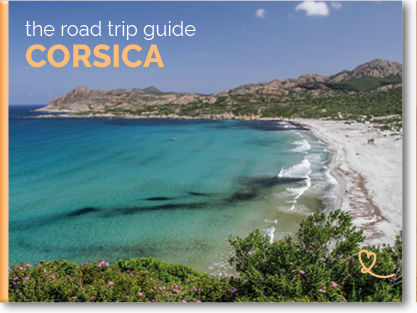
The village of Aléria
Around the ruins and the museum is the small village of Aléria.
It is a typical Corsican village with a small church and large gray houses.
Here is the view of the village from the ruins:

Here is the church in the center of the village. You can’t miss it, it’s on the other side of the fort.
It is Saint-Marcel, an old church of Romanesque style. It was built in part with stones from the Roman city.
She is known for her paintings.

The village is built on slightly elevated ground. From the village you have a good view of the region and the river Tavignano. The river was essential to the settlement for life and agriculture.

Archaeological Museum of Aléria Jérôme-Carcopino (Fort of Matra)
Your first stop is Fort Matra. It was originally built by the Genoese in the late 14th century and has been restored many times.
It was built in a strategic location (on higher ground) to monitor the entire region.
It was an arms depot for the Genoese. And during the Corsican rebellion, it was partially destroyed in 1729.
The fort was rebuilt and became the property of the Matra family, hence its name.

This is where you get your admission ticket.
It houses the Jerome Carcopino Museum, the regional museum of archaeology. It is named after a famous historian of the Roman period.
It is definitely worth a visit. The exhibits are mostly in excellent condition.
Aléria had a long history until its destruction in the 5th century.

You can find many dishes, ceramics, vases, bronze weapons, coins and objects of daily life.
Among the most famous pieces, we find:
- a white marble bust of Jupiter-Hammon with rams’ horns
- the statue of a lion lying down of Etruscan type
And our favorite, most intriguing pieces are
- the dog head you can see at the beginning of the article
- dice to play with

Subscribe to our Newsletter
- Get away from it all with Region Lovers’ beautiful destinations!
- Once a month
- Advertising-free
Aléria – Archaeological site (Roman ruins)
Then you can walk to the excavated ruins. It is a short and easy walk.
Don’t forget to keep your ticket with you.

The site is not huge.
There are many explanatory panels to understand what you are looking at and how the city was organized. Here is a map of Aleria as deduced from the ruins:

Here is a summary of what was found:
- The forum was built between the 2nd and 1st century BC. It is located in the center of the excavated ruins.
- Stores were set up on each side of the forum. Those on the south side are better preserved. You can see a series of individual spaces.
- Arches were in place to access the forum.
- The present site contains at least 2 temples facing west and east of the forum. Both had been rebuilt over the centuries.
- The best preserved elements are the basins and the most recent water tanks. More than 10 water reserves are known to have existed.
- Thermal baths were installed in the Balneum which was to be an imposing building.
- Other baths were found on the site, some public and others transformed for private use.

You can walk around and explore the different parts of the site. It is easy to walk around with a view of the village, the valley and the sea.


HOW TO GET TO Corsica
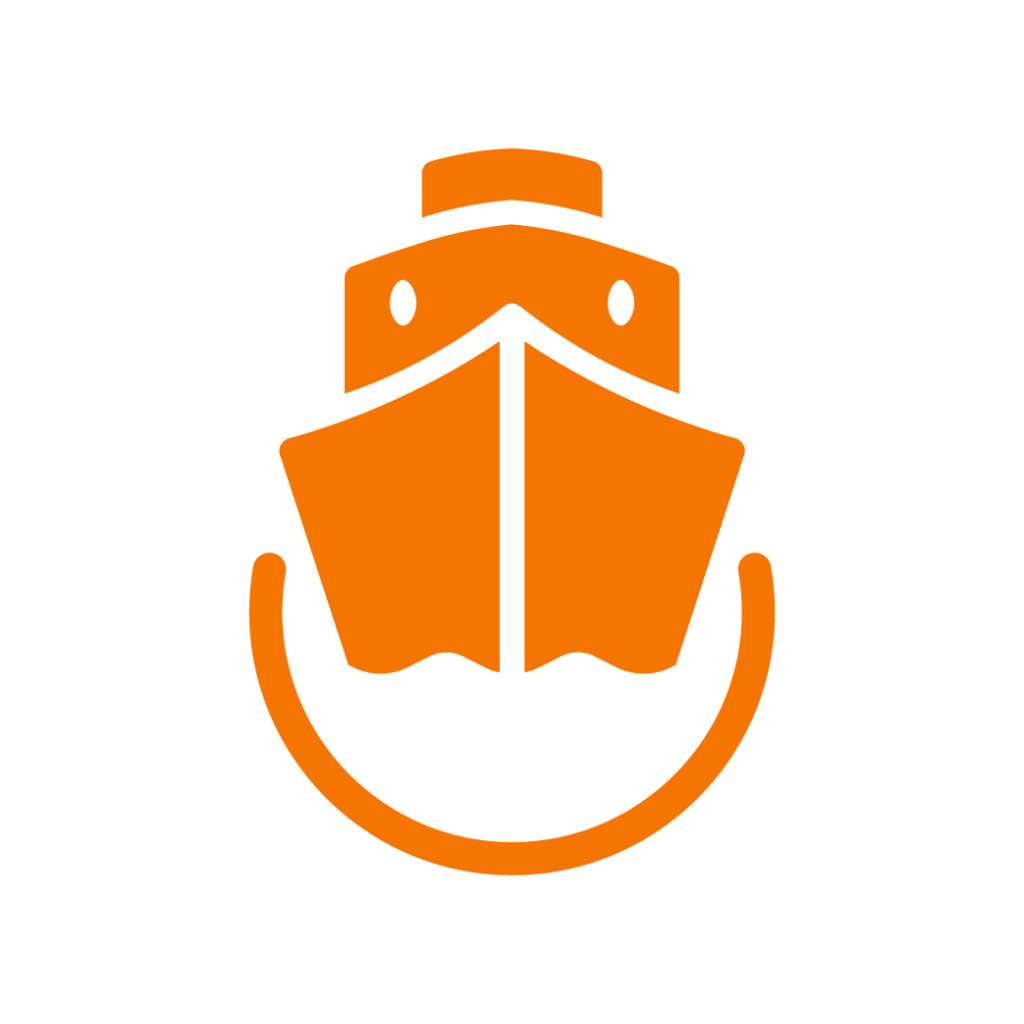
Option 1: by ferry
Departure from France and Italy
- See all ferry options in our article
- Compare schedules, prices and availability directly
Advantage: you can take your car!

Option 2: by plane
Airports in Bastia, to visit the North, Figari to visit the South, or Ajaccio convenient for all Corsica.
Compare flights!
What to do around Aléria
The main interest of the area is the ancient site, but if you have a little more time in the area, here are some other ideas to discover.
Diane’s Pond and Diane’s Tower
If you like mussels, the region is also famous for the Etang de Diane.
It was a strategic port for the region.
Today, it is known for its aquatic environment.
It is a fishing and aquaculture center.
Its most famous products are mussels. You can even find places to taste them at the water’s edge.
At the end of the pond, you will find the Tower of Diana. The access is only by a dirt road.
It is a Genoese tower of the 16th.
Agriculture and Vineyards – Aléria cellar
Unlike the other coast of Corsica, on this side, the mountains do not fall directly into the water.
There is flat land in between, which is ideal for farming.
You can find vineyards with beautiful views of the mountains.

Between sea and mountain, they produce white, rosé and red wines.
Here the grains cultivated since the VIth century are gorged with sun.
The wines have black fruit accents, minerality and smooth tannins.
The grape varieties you will find there include:
- Vermentinu, a very old white grape variety with citrus notes
- the Biancu Gentile, also a white, with notes of lemons
- the Sciaccarellu in rosé, with its notes of flowers of the maquis
- the Niellucciu, a red with notes of red fruits, violet and apricot.
The local cooperative is Les Caves d’Aléria. See site.
And the scenery is really nice when you drive south.

PLAN YOUR TRIP TO Corsica
Inspiration destinations

Best of
- The most beautiful beaches of Corsica
- The most beautiful villages of Corsica
- The most beautiful cities of Corsica
- The most beautiful destinations in Corsica
- The museums of Corsica
- Hidden gems in Corsica
- The most beautiful natural pools
- What to do in North Corsica
- Best things to do in South Corsica
- Canyoning in Corsica
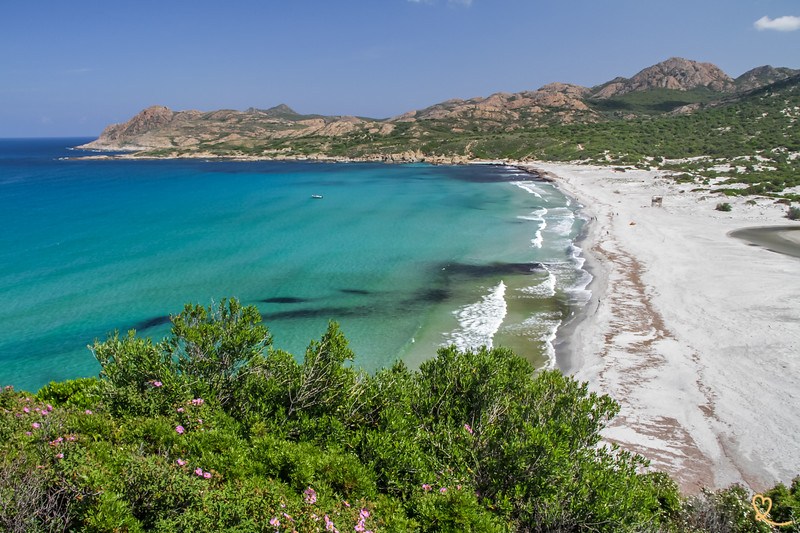
Where to stay

Beaches near Aléria: Padulone, Chiola…
The beaches near the town of Aleria are mostly long stretches of gray sand.
It’s not bad, the sand is quite fine and pleasant. But they do not have the charm of all the beautiful beaches of Corsica.

The nearest beach is Padulone. It is located south of the pond of Diane.
It has 2 restaurants near the parking lot.
One of the first beaches to consider is Chiola, 30min down on the T10 roads.
For more golden sand, you should go south.
But if you want stunning white sand beaches, you have to go to the Porto-Vecchio area(read more).
This is the beach of Chiola:

Parade of Inzecca
East of Aleria, don’t miss one of our favorite activities in Aleria: driving the Inzecca canyon.
It is often ignored by visitors who prefer to drive further south and head for the canyon of Solenzara where it is easy to swim.

Inzecca is not an ideal place for swimming, but the short drive is fascinating with its narrow gorges, lush vegetation, white rocks and steep rock faces.

This was one of my favorite views. Impressive, isn’t it?

Other Roman ruins in Corsica : Mariana (North)
If you like Roman ruins, the other major site to visit in Corsica is Mariana.
It is located in the north of the island, just south of Bastia.
The site is smaller, but a large museum is under construction just across the road and is expected to become a major archaeological site.

Frequently asked questions
Where does the name Aléria come from?
The Etruscan name was Alalia.
When the city is taken by the Romans in 259 BC, it becomes Aléria.
The Latin name means eagle.
